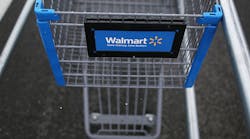Wal-Mart Stores Inc. has joined a new program that rates companies on their use of chemicals, a move that puts fresh pressure on the consumer-products industry to police its ingredients.
The world’s largest retailer is participating in the Chemical Footprint Project, which seeks to help companies root out dangerous substances from the products they sell. Two dozen companies have joined the effort, including Johnson & Johnson, HP Inc. and Staples Inc., according to a report on Wednesday. The idea was to create a standard modeled on carbon-footprint scores.
Wal-Mart’s involvement gives a big boost to the three-year-old program and underscores the growing movement by corporate America to regulate itself. Consumers are increasingly checking ingredient labels of the products they buy -- and pushing companies to rid products of controversial chemicals, such as formaldehyde or phthalates.
“We ultimately want to build trust in Wal-Mart’s brand,” said Zach Freeze, head of the retailer’s strategic initiatives around sustainability. The program provides a “more holistic approach” and guidance for companies looking to manage their use of chemicals.
As part of the project, companies take a 20-question survey that examines their policies, goals and actions aimed at reducing toxic substances -- along with how much information they disclose. The top score is 100 points.
Three of the companies that took the assessment disclosed their scores. Medical-device maker Becton Dickinson had a 53, and equipment company Case Medical scored 62. The cosmetics maker Beautycounter, which advertises that it doesn’t use more than 1,500 suspect chemicals in its products, posted a 92.
The Chemical Footprint Project was created by an organization called Clean Production Action in 2014. The move was a response to demand from both consumers and investors, who are increasingly concerned about the hazardous chemicals that companies use, said Mark Rossi, the group’s executive director.
Financial Risks
“There are literally chemical risks from a financial perspective, and investors generally don’t have a window into that,” Rossi said.
Costs related to exposure to bisphenol A, a substance common in products like the linings of canned foods, are estimated to be 163 billion euros a year in the European Union alone, according to the report.
Before the Chemical Footprint Project was started, companies lacked a third-party standard to evaluate supply chains and risks posed by hazardous products, Rossi said.
Boston Common Asset Management, an investment firm that focuses on social and eco-friendly causes, is one of the 65 signatories to the project. More consumers are starting to question how things are made and where their products are coming from, said Brian Chiappinelli, head of the firm’s business development. Wall Street, too, is focusing more on sustainability issues, he said.
“It’s about the evaluation of risk,” Chiappinelli said. “Regulation agencies try to do their best, but it’s not always the case that they do everything.”
Supplier Pressure
Three-quarters of the companies that participated in the assessment said they have a policy to find hazardous substances and substitute safer alternatives, while 92% said they’ve developed a list of so-called chemicals of high concern.
Wal-Mart announced in 2013 that it would ask suppliers to find safer alternatives for chemicals in personal care, cleaning and beauty products. Last year, it named the first group of chemicals it’s asked vendors to remove. Freeze said the company is still targeting next year for suppliers to list those substances on packaging.
Wal-Mart and HP are among those that signed on since the first report was issued last year. Freeze said Wal-Mart had been following the launch of the program closely since it began. It doesn’t plan to publicize its results this year, but that may change.
“We want to be more transparent,” Freeze said. “We do want to lead.”
By Lauren Coleman-Lochner and Taylor Cromwell



